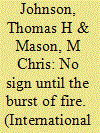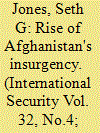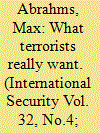| Srl | Item |
| 1 |
ID:
080962


|
|
|
|
|
| Publication |
2008.
|
| Summary/Abstract |
The Pakistan-Afghanistan border area has become the most dangerous frontier on earth, and the most challenging for the United States' national security interests. Critically, the portion of the border region that is home to extremist groups such the Taliban and al-Qaida coincides almost exactly with the area overwhelmingly dominated by the Pashtun tribes. The implications of this salient fact-that most of Pakistan's and Afghanistan's violent religious extremism, and with it much of the United States' counterterrorism challenge, are contained within a single ethnolinguistic group-have unfortunately not been fully grasped by a governmental policy community that has long downplayed cultural dynamics. The threat to long-term U.S. security interests in this area is neither an economic problem, nor a religious problem, nor a generic "tribal" problem. It is a unique cultural problem. In both southern Afghanistan and the tribal areas of Pakistan, rather than seeking to "extend the reach of the central government," which simply foments insurgency among a proto-insurgent people, the United States and the international community should be doing everything in their means to empower the tribal elders and restore balance to a tribal/cultural system that has been disintegrating since the Soviet Union invaded Afghanistan in 1979.
|
|
|
|
|
|
|
|
|
|
|
|
|
|
|
|
| 2 |
ID:
080965


|
|
|
|
|
| Publication |
2008.
|
| Summary/Abstract |
Some scholars have proposed partition as a way to solve ethnic civil wars. Partition theorists advocate the demographic separation of ethnic groups into different states, arguing that this is the best chance for an enduring peace. Opponents argue that partition is costly in terms of its human toll and that its advocates have yet to demonstrate its effectiveness beyond a limited number of self-selected case studies. This analysis systematically examines the outcome of partition, highlighting the centrality of demography by introducing an index that measures the degree to which a partition separates ethnic groups. This index is applied to all civil wars ending in partition from 1945 to 2004. Partitions that completely separated the warring groups did not experience a recurrence of war and low-level violence for at least five years, outperforming both partitions that did not separate ethnic groups and other ethnic war outcomes. These results challenge other studies that examine partition as a war outcome. The results also have direct implications for Iraq's civil war, postindependence Kosovo, and other ethnic civil wars
|
|
|
|
|
|
|
|
|
|
|
|
|
|
|
|
| 3 |
ID:
080964


|
|
|
|
|
| Publication |
2008.
|
| Summary/Abstract |
Postconflict state reconstruction has become a priority of donors in Africa. Yet, externally sponsored reconstruction efforts have met with limited achievements in the region. This is partly due to three flawed assumptions on which reconstruction efforts are predicated. The first is that Western state institutions can be transferred to Africa. The poor record of past external efforts to construct and reshape African political and economic institutions casts doubts on the overly ambitious objectives of failed state reconstruction. The second flawed assumption is the mistaken belief in a shared understanding by donors and African leaders of failure and reconstruction. Donors typically misread the nature of African politics. For local elites, reconstruction is the continuation of war and competition for resources by new means. Thus their strategies are often inimical to the building of strong public institutions. The third flawed assumption is that donors are capable of rebuilding African states. Their ambitious goals are inconsistent with their financial, military, and symbolic means. Yet, African societies are capable of recovery, as Somaliland and Uganda illustrate. Encouraging indigenous state formation efforts and constructive bargaining between social forces and governments might prove a more fruitful approach for donors to the problem of Africa's failed states
|
|
|
|
|
|
|
|
|
|
|
|
|
|
|
|
| 4 |
ID:
080961


|
|
|
|
|
| Publication |
2008.
|
| Summary/Abstract |
In 2002 Afghanistan began to experience a violent insurgency as the Taliban and other groups conducted a sustained effort to overthrow the Afghan government. Why did an insurgency begin in Afghanistan? Answers to this question have important theoretical and policy implications. Conventional arguments, which focus on the role of grievance or greed, cannot explain the Afghan insurgency. Rather, a critical precondition was structural: the collapse of governance after the overthrow of the Taliban regime. The Afghan government was unable to provide basic services to the population; its security forces were too weak to establish law and order; and there were too few international forces to fill the gap. In addition, the primary motivation of insurgent leaders was ideological. Leaders of the Taliban, al-Qaida, and other insurgent groups wanted to overthrow the Afghan government and replace it with one grounded in an extremist interpretation of Sunni Islam
|
|
|
|
|
|
|
|
|
|
|
|
|
|
|
|
| 5 |
ID:
080963


|
|
|
|
|
| Publication |
2008.
|
| Summary/Abstract |
What do terrorists want? No question is more fundamental for devising an effective counterterrorism strategy. The international community cannot expect to make terrorism unprofitable and thus scarce without knowing the incentive structure of its practitioners. The strategic model-the dominant paradigm in terrorism studies-posits that terrorists are political utility maximizers. According to this view, individuals resort to terrorism when the expected political gains minus the expected costs outweigh the net expected benefits of alternative forms of protest. The strategic model has widespread currency in the policy community; extant counterterrorism strategies seek to defeat terrorism by reducing its political utility. The most common strategies are to fight terrorism by decreasing its political benefits via a strict no concessions policy; decreasing its prospective political benefits via appeasement; or decreasing its political benefits relative to nonviolence via democracy promotion. Despite its policy relevance, the strategic model has not been tested. This is the first study to comprehensively assess its empirical validity. The actual record of terrorist behavior does not conform to the strategic model's premise that terrorists are rational actors primarily motivated to achieving political ends. The preponderance of empirical and theoretical evidence is that terrorists are rational people who use terrorism primarily to develop strong affective ties with fellow terrorists. Major revisions in both the dominant paradigm in terrorism studies and the policy community's basic approach to fighting terrorism are consequently in order
|
|
|
|
|
|
|
|
|
|
|
|
|
|
|
|